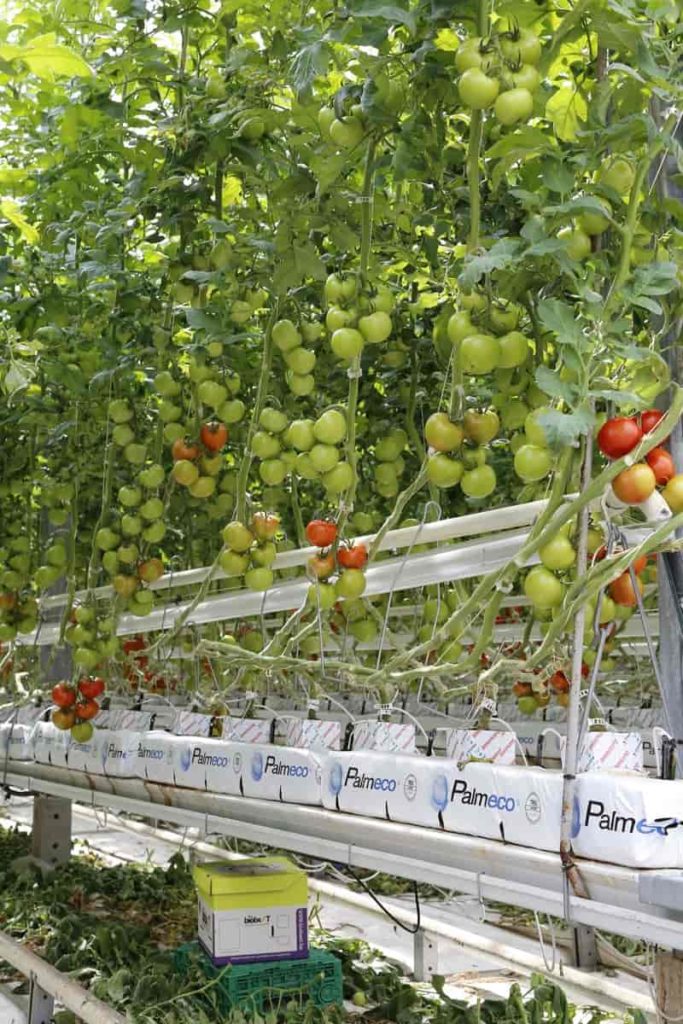Tomatoes are the most widely grown vegetable in the United States. Tomatoes (Solanum Lycopersicum L), members of the nightshade family, are nutritionally dense, widely available, affordable, commonly used in diverse cuisines, and preferred by all ages. The USA produces more than $2 billion worth of commercial Tomatoes each year, mainly in California (the leader in the processing market) and Florida (the leader in the fresh market). Let’s check out how to start Tomato farming in the USA below.
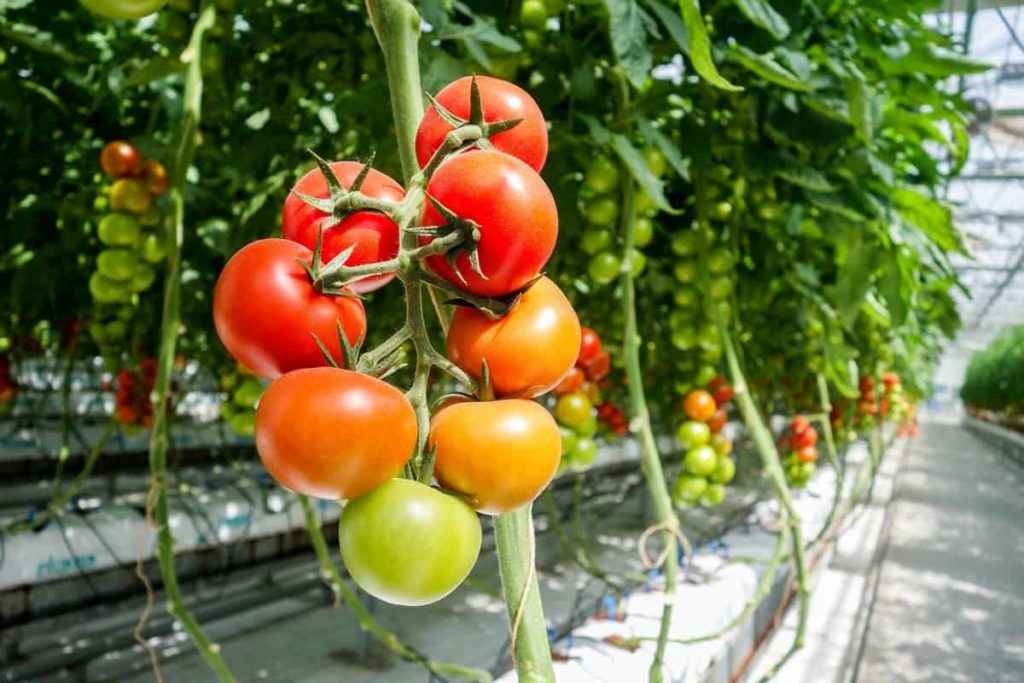
Tomato production requires intensive management, production and marketing skills, and a significant investment. Production costs per acre are high, and environmental pest problems can severely limit yields. The US Tomato processing industry, which consists primarily of Tomato paste, sauces, and canned Tomato products, is quite separate from the fresh market industry. Tomatoes have essential nutrients; they are a good source of vitamin C, vitamin A, and antioxidants.
How to start Tomato farming in the USA
Top Tomato-producing states in the USA
Tomatoes are the leading vegetable processing crop in the United States. California and Florida are the major US states for Tomato production for fresh market consumption. The plant originated in Mexico but spread around the world through Spanish colonization. The three largest producers of Tomatoes in the United States are Indiana, Florida, and California.
However, the top 10 Tomato-producing states are Tennessee, Florida, South Carolina, Virginia, North Carolina, Ohio, New Jersey, California, Michigan, and Indiana. California is the leading Tomato producer in the United States. Other major Tomato producers are Indiana, Michigan, and Ohio. California and Florida are the newest market Tomato-producing states in the United States. Ohio, Tennessee, Virginia, and Georgia also produce significant fresh market Tomatoes.
California – California produces 2,55,388 thousand centum weight (cwt) Tomatoes yearly. As a result, it is the largest producer of Tomatoes in the United States and the largest producer of Tomatoes in the world. California produces 2,55,388 thousand centum weight (cwt) Tomatoes each year. As a result, it is the largest producer of Tomatoes in the United States and the largest producer of Tomatoes in the world.
More specifically, about one-third of the world’s Tomatoes and 95 percent of the United States are produced in California. Some areas where Tomatoes are grown include the Sacramento Valley and the San Joaquin Valley. Production occurs mainly in Solano, Merced, Sutter, and Stanislaus counties. The main planting period is from late January to early June, while the harvesting season is from late June to October.
Florida – Florida is the second largest producer of Tomatoes in the United States. Tomato production areas in Florida include Tampa Bay and Dade County. Some of the most popular Tomato varieties grown in Florida are Floragold, Everglades, and Better Boy. Suitable planting seasons for this state are March and August. Florida produces about 50 percent of the fresh Tomatoes in the United States.
Indiana – Indiana is the third largest Tomato producer in the United States, producing 4,940 thousand cwt. Farmers in Indiana grow both fresh market Tomatoes and processed Tomatoes.
Ohio – Ohio is the fourth largest producer of Tomatoes in the United States, with an annual production of 2,808 thousand cwt. The best varieties for Ohio farms are Early Grill, Sun Gold, Brandywine, and Roma. The state has a short growing season that begins in late May.
Best season for Tomato farming in the USA
The Tomato is considered a mild warm-season crop but is a perennial plant, while it is cultivated as an annual. The Tomato plant is sensitive to frost and will not grow outdoors permanently in most parts of the country. Most cultivated Tomatoes take about 75 days from transplant to first harvest and can be grown for several weeks before yield declines. The ideal temperature for growing Tomatoes is 21-29˚C during the day and 18-21˚C at night.
In case you missed it: High Yield Tomato Varieties in India: A Farmer Guide for Good Profits
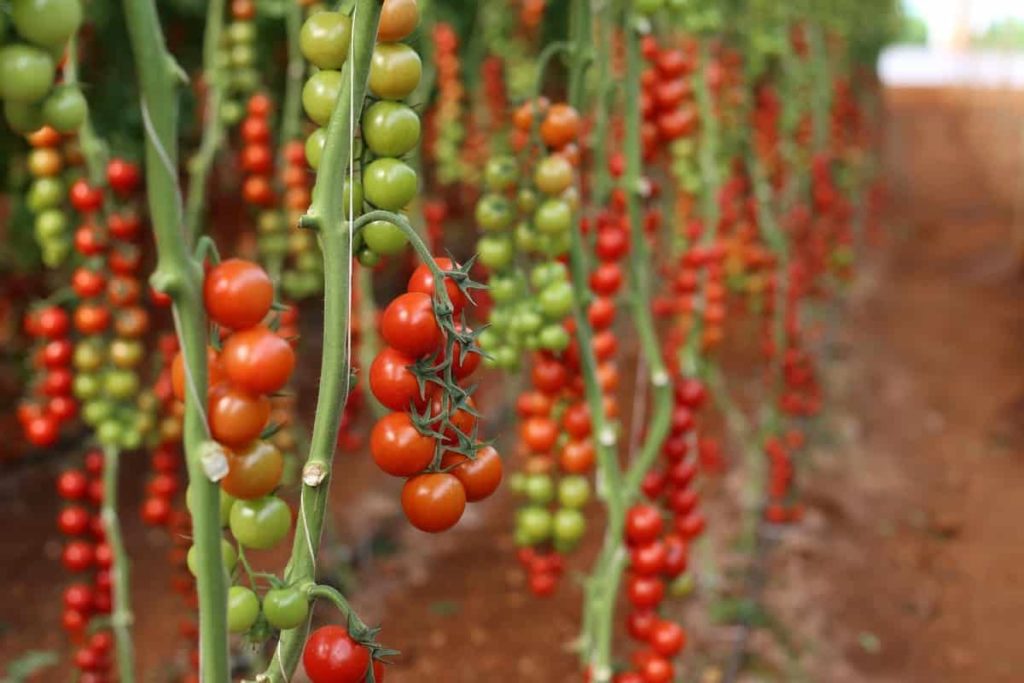
Significantly higher or lower temperatures can adversely affect fruit set and quality. Tomato is a self-pollinating plant and can be effectively pollinated outdoors by wind currents. The best time of year to grow your Tomatoes depends on a few key factors, including:
- Temperature
- Location
- Tomato plant type
- Days to maturity
Tomato plants are warm-season tender crops that love the sun and are frost-tolerant. Due to the long growing season required for this heat-loving crop, several states in the US Sun Belt became major Tomato producers, mainly Florida and California. Tomato plants are cultivated under irrigation for California’s fresh fruit market and canning and processing. Therefore, the California University, Davis (UC Davis) became the main center of Tomato research.
In California, growers have used a dry farming method, mainly with Early Girl Tomatoes. This method encourages the plant to send roots deeper to find moisture in the soil that retains moisture, such as loam. If you’re in the USA and within USDA hardiness zones 8 and 9, start your seeds in mid-January. However, if you are in USDA zone three or four, you should start your seeds between mid-March and early April.
Fresh Tomatoes are produced year-round in California, except in winter. Fresh Tomatoes are produced from October to June, with peaks in April–May and November–January in Florida. Other top Tomato-producing states in the USA (Georgia, North Carolina, Ohio, Tennessee, and Virginia) produce Tomatoes during the summer when Florida is out of the market.
Different Tomato varieties in the USA
- Beefsteak Tomato (British English) is one of the largest varieties of cultivated tomatoes, some weighing 450 grams (1 lb) or more. Beefsteak Tomato is usually pink or red, with numerous small seed pods distributed throughout the fruit, sometimes pre-Columbian Tomatoes. Common in the United States. Red Ponderosa and Coustralee varieties are included.
- ‘Sun Gold’ (cherry Tomato, indeterminate) Fruits are produced in large quantities on vines and are prone to cracking after rain, so plant them in well-drained soil, away from heavy rains. Harvest the ripe fruit first.
- ‘Kellogg’s Breakfast’ (beef steak, unspecified) is best flavored with orange-sliced Tomatoes. Its large, light fruits are bright orange with smooth, fleshy flesh that is fruity, sweet, and flavorful. Heat-loving vines are very productive.
- ‘Carbon’ (Slicer, indeterminate) has large, firm, juicy fruits of deep purplish-red color.
- ‘Flamme’ or ‘Jaunne Flamme’ (saladette, indeterminate, heirloom) is an early bearer that produces loads of small, round, bright orange salad Tomatoes on productive vines.
- Roma paste Tomatoes are a good choice for gardeners in California’s Central Valley, where summer temperatures often climb into the triple digits, according to Redwood Barn Nursery in Roma-Davis. Plum-shaped Tomatoes grow on set plants, so they remain compact, making them a good choice for growing in pots or containers on patios and balconies. The Roma Tomato variety is a good-tasting salad Tomato, and its low water content makes it suitable for sauces.
- Solar set – This hybrid Tomato variety comes from the University of Florida, which developed it in response to the need for a home-grown Tomato that withstands the state’s harsh summers.
- Some other varieties are Hungarian Heart and Mushroom Basket.
In case you missed it: Top 24 Steps to Boost Tomato Yield: How to Increase Production, Quality, and Size
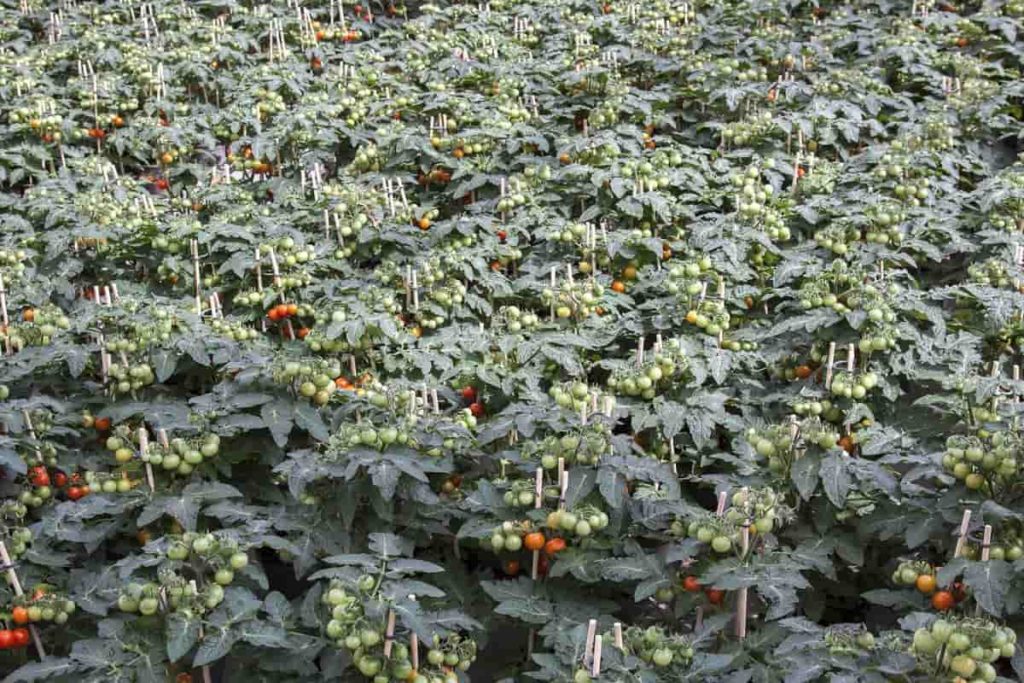
Soil requirements and site preparation for Tomato planting in the USA
Tomatoes can be grown on a variety of soil types. Avoid sites that tend to stay wet. Choose sites with good air circulation (to reduce disease) and are weed-free. Plants depend on soil for physical support, anchorage, nutrients, and water in field production. The extent to which soil provides these three factors depends on topography, soil type, soil texture, and soil management.
For Tomato production, proper tillage is important for land management and optimum yield. Land preparation should include sufficient tillage operations to make the land suitable for planting or transplant establishment and to give the best soil structure for root growth. The soil profile influences the extent to which the Tomato plant’s root systems develop. Root growth will be mainly restricted if there is a hard pan, compacted layer, or heavy soil zone.
Tomatoes are known to be deep-rooted; some roots grow as deep as 10 feet under favorable conditions. However, most roots will be in the top 12 to 24 inches of soil. Because compacted soil severely limits root growth, proper preparation should eliminate or significantly reduce soil compaction and hardpan. Tillage systems using moldboard (“bottom” or “turning”) plows produce the greatest amount of soil suitable for solid root growth.
It allows for the development of more extensive root systems, which can access nutrients and water in the soil more efficiently. Discing after moldboard plowing re-compacts the soil and should be avoided. Compaction pans are present in many soils. They are mainly created by machinery and are usually located deep in or under the plow.
Although compaction pans may only be a few inches thick, their inhibitory effects on root growth can significantly reduce Tomato yields. After soil preparation, even parallel raised beds are created, and a drip irrigation system is installed. Raised beds are usually covered with thick plastic. Young Tomato plants germinate in greenhouses and are transplanted into fields by hand or using special mechanical equipment.
Most fresh market Tomatoes, such as those grown in Florida and some areas of California, are grown with a support system such as metal poles or wooden stakes. This support system allows for higher product quality by keeping fruit off the ground, increasing yield, and allowing harvest crews to enter the field for multiple picks without jeopardizing plant integrity.
Plant spacing for crop productivity
Tomatoes can be planted in many arrangements that provide adequate space for plant growth. Spacing is often based on the training and equipment used in the field. The within-row and between-row spaces are chosen to meet these limits. Maximum plant population per acre may also be influenced by plant growth habit (compact, spreading), plant size at maturity (small, medium, large), specific cultivar vigor, climate, soil moisture, and nutrient availability, which may also be affected by management systems and soil productivity.
Generally, a minimum of 5 feet between rows of 18 to 24 inches is used to produce determinate varieties of Tomatoes. A six-foot spacing between rows is also a popular spacing. Planting 22 inches in rows 5 feet apart requires 4,760 plants per acre. With 6-foot centers and 18 inches between plants, 4,840 plants are needed per acre.
In case you missed it: Tomato Farming In Karnataka, Areas, Seasons, Yield
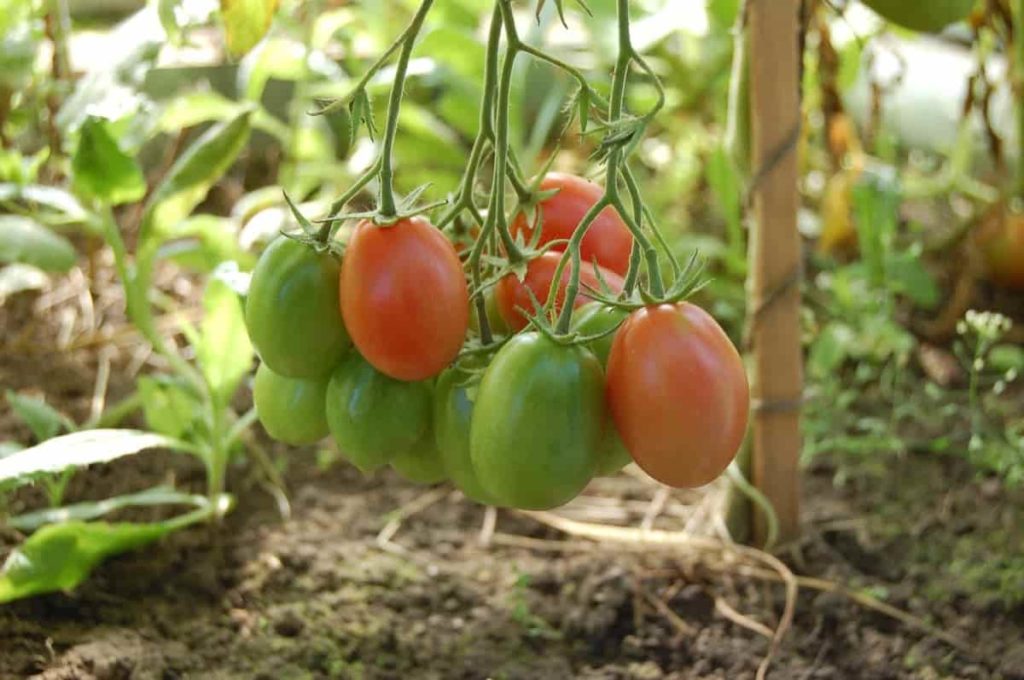
A row of Tomatoes is usually planted in the center of each plastic mulched bed. On bare ground, plant rows 48 to 72 inches apart with 18 to 24 inches between plants in the row. Adjust spacing to reduce populations accordingly for indeterminate Tomato varieties that produce large plants.
Best conditions for growing Tomatoes in the USA
Fresh Market Tomatoes are available year-round due to overlapping growing seasons in Florida, California, and other growing states. Imports from the Mexican and Canadian greenhouse industries also contribute to the availability of fresh tomatoes during the winter months when US domestic production is at its lowest.
During the winter months, Florida Tomatoes are shipped primarily to states in the eastern United States and imported Mexican Tomato varieties account for most of the Tomatoes sold in the West. Tomato is a warm-season crop sensitive to frost at any growth stage. Daily maximum air temperatures between 22 and 35˚C are optimal for plant growth.
Tomato plants can tolerate temperatures well above 37˚C, although extremely hot temperatures can adversely affect developing fruit. Tomato plants grow well in various soil textures, but commercial growers prefer the sandy soils in most of Florida’s and California’s coastal regions. Sandy soils heat up more easily than well-drained and dense soils.
Denser soils such as loam and clay loam can also be used if fields are carefully irrigated and have good drainage. A denser soil texture is more common in the growing regions of the Central Valley in California. Universally, all soils are prepared before planting using specialized equipment to improve overall soil quality by breaking up clods and adding amendments.
Irrigation and fertilizer management for Tomato farming in the USA
The irrigation type used in Tomato fields depends on the water resources in the growing area. In some areas of Florida, where water is abundant, furrow irrigation is used. In California, a drip irrigation system is used exclusively because of its efficient water use. Overhead sprinklers are used to help establish new Tomato transplants.
Commercial Tomato growers use chemical fertilizers or properly composted organic materials to feed growing plants. Fertilizer is applied before transplanting, side-dressed in a furrow irrigation system, or applied by drip irrigation. The term “chemigation” is the injection of a chemical such as nitrogen, phosphorus, or pesticide into irrigation water and applied to land using an irrigation system.
Apply any necessary lime 2 to 3 months before installation of plastic mulch. The application of pre-plant fertilizer will vary with bed size and planting scheme. On large beds (4 feet wide or more), it is advisable to add all phosphorus and micronutrients to the bed before applying plastic. Also, apply all nitrogen and potassium preplant if drip fertigation is not used. Pre-planting all necessary fertilizers can lead to fertilizer salt toxicity if narrow beds are used.
Side dressing is required by liquid injection wheel, drip irrigation, or banding outside the fragmented part of the bed. Most Tomatoes are grown where fertigation is used with drip irrigation. In these cases, all the phosphorus (P) and micronutrients and one-third to one-half of the nitrogen (N) and potassium (K) should be added to the bed before laying the plastic. Apply the remaining N and K by weekly fertigation immediately after transplant establishment. The application rate of these fertigations will vary with the stage of the crop.
In case you missed it: Tomato Farming in Polyhouse for Profit – A Full Guide
Tomato marketing in the USA
The two segments of the industry have different marketing methods. The majority of fresh Tomatoes are hand-picked and sold in the open market. In contrast, all processed Tomatoes are mechanically harvested and then sold under contract, with only 1 percent sold in the open market. Fresh-market Tomatoes are grown in every state in the United States, with commercial-scale production occurring in about 20 states.
Florida and California produce the majority of commercially grown fresh market Tomatoes in the US – about 30 million pounds per year. Florida ranks first in the fresh market Tomato production. Major Tomato production areas are located in South Florida, Central Florida (south of Tampa), and a small production area in Northwest Florida. California is the second largest producer of fresh market Tomatoes and contributes significantly to the fresh market Tomato crop produced in the United States.
Tomatoes are grown in almost every county in California, but most fresh market Tomatoes are grown in and around the Central Valley. Other major South Coast fresh market-producing states are Virginia, Georgia, Ohio, Tennessee, North and South Carolina, New Jersey, and Michigan.
Tomato production importance in the USA
The largest Tomato-producing states in the USA are California and Florida. Tomato is an annual vegetable that takes about 75 days from transplanting to the first harvest. Production costs per acre can be high and present complex problems for the grower, who must be knowledgeable about soil, fertilizer, pest control, harvesting, marketing, and other record-keeping necessary for agribusiness.
Fresh-market Tomato varieties are produced in every state in the USA, with commercial-scale production in about 20 states. Florida overtook California as the top producer, likely due to the ongoing drought in California. Tomatoes are warm-season crops; at any growth stage, they are sensitive to frost, so field planting in temperate climates occurs when the risk of frost has passed in the spring or transplants.
Row covers are planted and grown in late spring. Tomatoes in temperate climates are also grown in greenhouses and under high tunnels covered with plastic to extend the Tomato production season. The emergence of greenhouse Tomato farming has begun to change the shape of the US fresh market Tomato industry.
Greenhouse Tomato farming allows producers to grow fresh Tomatoes in a structure, sometimes using climate control and alternative soil methods. The advantages of greenhouse production include uniform appearance and quality, consistency of yield, increased yield per acre, and increased ability of the grower to maintain year-round production.
Cost of growing Tomatoes in the USA
The Tomato growing cost varies depending on the variety of Tomatoes grown, stocking methods, and fertilization and labor costs. You can expect 200 to 400 hours of labor per acre for a growing season, costing $2,000. You must successfully produce approximately 15 tons of Tomatoes. As you gain experience in Tomato production, costs may decrease.
Tomato yield in the USA
The United States produces about 1.4 million metric tons of Tomatoes for fresh consumption. The largest portion of US Tomato production is used for further processing. California and Florida are the major US states for Tomato production for fresh market consumption. Crop utilization has increased rapidly over the past 100 years. Approximately 400,000 acres of Tomatoes are cultivated in the USA.
Annual production exceeds about 14 million tons (12.7 million metric tons), of which more than 12 million tons are processed into different products like soups, catsup, sauces, salsas, and prepared foods. Another 1.8 million tonnes are produced for the fresh market. Global production exceeds 70 million metric tons. The number of 25-pound cartons counts as a Tomato harvest. An average acre of Tomatoes will produce over 37,500 pounds of red, ripe fruit. About 5000 Tomato plants are needed to meet this number.
In case you missed it: Cherry Tomato Farming in India; Planting; Care; Harvesting
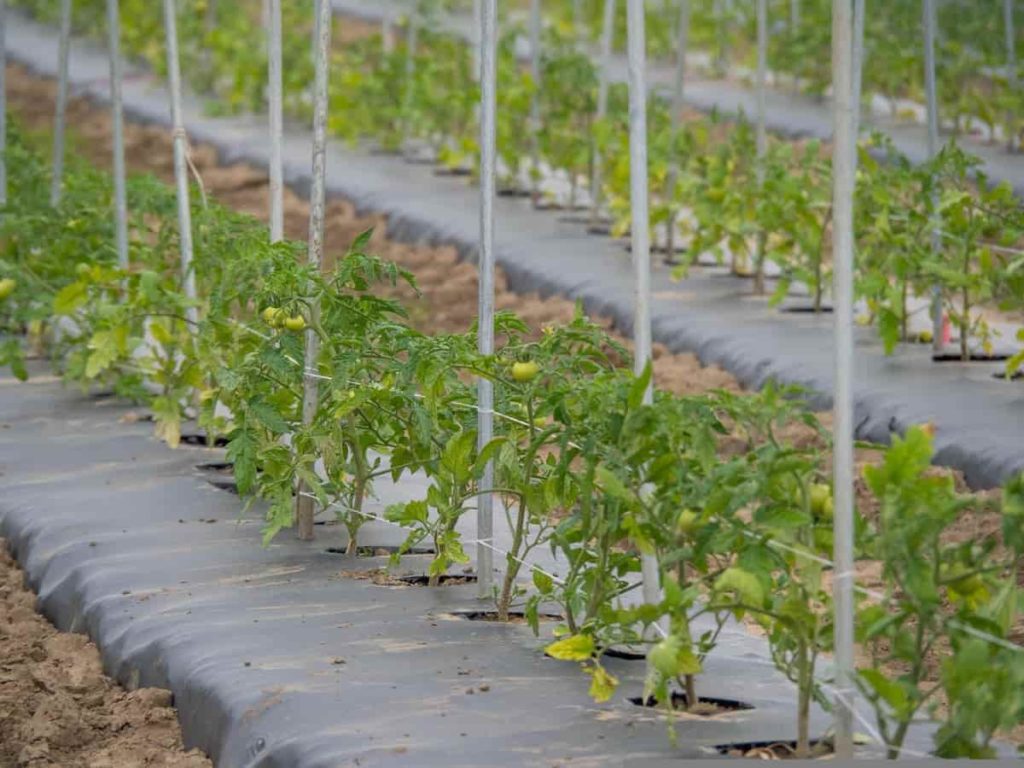
Challenges facing Tomato producers in the USA
- The first challenge is global climate change, resulting in unpredictable weather patterns. Thus, farmers must invest more in irrigation due to longer sunshine hours.
- Secondly, fluctuations in global Tomato prices also affect its production in the US as it is a major export component of states like California.
- The third challenge can be termed the imbalance of supply and demand. An example of such a scenario is an oversupply of Tomatoes with less demand. Ultimately, manufacturers have excess inventories that may take time to clear.
- Finally, Tomato growers face problems with common viruses such as early blight, leaf mold, blossom end rot, verticillium wilt, etc.
Conclusion
The United States is one of the world leaders in fresh Tomato production. Fresh Tomatoes are produced nationwide in the USA, with California and Florida being the top producers. Tomato production in the United States is among the six largest Tomato producers. Tomato is a warm-season vegetable crop.
California produces 90% of US Tomatoes, with about 4% going to the fresh market and the rest for processing. The USDA has reported total Tomato production for states outside California since all production in those states is for the fresh market. The above information is the best strategy to increase yields in Tomato farming in the USA.
- How to Make Houseplants Bushy: Effective Tips and Ideas
- Innovative Strategies for Boosting Coconut Pollination and Yield
- Pollination Strategies for Maximum Pumpkin Yield
- The Complete Guide to Chicken Fattening: Strategies for Maximum Growth
- Natural Solutions for Tulip Problems: 100% Effective Remedies for Leaf and Bulb-Related Issues
- Revolutionizing Citrus Preservation: Towards a Healthier, Greener Future
- Natural Solutions for Peony Leaf and Flower Problems: 100% Effective Remedies
- Maximizing Profits with Avocado Contract Farming in India: A Comprehensive Guide
- Natural Solutions for Hydrangea Problems: 100% Effective Remedies for Leaf and Flowers
- The Ultimate Guide to Choosing the Perfect Foliage Friend: Bringing Life Indoors
- From Sunlight to Sustainability: 15 Ways to Use Solar Technology in Agriculture
- The Ultimate Guide to Dong Tao Chicken: Exploring from History to Raising
- The Eco-Friendly Makeover: How to Convert Your Unused Swimming Pool into a Fish Pond
- Mastering the Art of Delaware Chicken Farming: Essentials for Healthy Backyard Flocks
- 20 Best Homemade Fertilizers for Money Plant: DIY Recipes and Application Methods
- How to Craft a Comprehensive Free-Range Chicken Farming Business Plan
- Brighten Your Flock: Raising Easter Egger Chickens for Beauty and Bounty
- How to Optimize Your Poultry Egg Farm Business Plan with These Strategies
- Subsidy for Spirulina Cultivation: How Indian Government Schemes Encouraging Spirulina Farmers
- Ultimate Guide to Raising Dominique Chickens: Breeding, Feeding, Egg-Production, and Care
- Mastering the Art of Raising Jersey Giant Chickens: Care, Feeding, and More
- Ultimate Guide to Raising Legbar Chickens: Breeding, Farming Practices, Diet, Egg-Production
- How to Raise Welsummer Chickens: A Comprehensive Guide for Beginners
- How to Protect Indoor Plants in Winter: A Comprehensive Guide
- Ultimate Guide to Grow Bag Gardening: Tips, Tricks, and Planting Ideas for Urban Gardeners
- Guide to Lotus Cultivation: How to Propagate, Plant, Grow, Care, Cost, and Profit
- Agriculture Drone Subsidy Scheme: Government Kisan Subsidy, License, and How to Apply Online
- Ultimate Guide to Raising Araucana Chickens: Breed Profile, Farming Economics, Diet, and Care
- Bringing Hydroponics to Classroom: Importance, Benefits of Learning for School Students
- Ultimate Guide to Raising Polish Chickens: Breed Profile, Farming Economics, Diet, and Care
- Ultimate Guide to Raising Australorp Chickens: Profile, Farming Economics, Egg Production, Diet, and Care
- Silkie Chicken Farming: Raising Practices, Varieties, Egg Production, Diet, and Care
- Sussex Chicken Farming: Raising Practices, Varieties, Egg Production, Diet and Care
- Homemade Feed Formulations for Livestock: Discover Cost-effective Starter to Finisher Feed Recipes
- 20 Best Pig Weight Gain Supplements: Top Swine Weight Gain Formulas
- Ultimate Guide to Elderberry Farming: Propagation, Planting, Yield, Cost, and Profit
